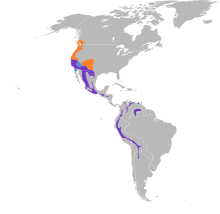Band-tailed pigeon
This article may not provide balanced coverage on a geographical region. (September 2017) |
| Band-tailed pigeon | |
|---|---|

| |
| In San Luis Obispo , California, USA
| |
| Scientific classification | |
| Domain: | Eukaryota |
| Kingdom: | Animalia |
| Phylum: | Chordata |
| Class: | Aves |
| Order: | Columbiformes |
| Family: | Columbidae |
| Genus: | Patagioenas |
| Species: | P. fasciata
|
| Binomial name | |
| Patagioenas fasciata (Say, 1822)
| |

| |
| Synonyms | |
|
Columba fasciata (Say, 1823) | |
The band-tailed pigeon (Patagioenas fasciata)
Taxonomy
Its closest living relatives are the Chilean pigeon and the ring-tailed pigeon, which form a clade of Patagioenas with a terminal tail band and iridescent plumage on their necks.[4] There are at least 8 sub-species, and some authorities split this species into the northern band-tailed pigeon (Patagioenas fasciata)[5] and the southern band-tailed pigeon (Patagioenas albilinea).[6][7]
Use as genetic proxy
The band-tailed pigeon is the closest living relative of the extinct passenger pigeon and has been investigated for being used in efforts to bring back that species.[8][9]
Distribution and habitat
It ranges from
Description

It is the largest pigeon in North America, measuring 33 to 40 cm (13 to 16 in) long and weighing 225–515 g (7.9–18.2 oz).[10][11] The coastal subspecies P. f. monilis (averaging 392 g (13.8 oz)) is larger than the inland subspecies (averaging 340 g (12 oz)).[10] The band-tailed pigeon has a wingspan of 66 cm (26 in).[12]
The plumage is gray, somewhat darker above. The head and underparts have a faint pink cast, especially in the adult male; the belly is nearly white. The distal half of the tail is also pale (except in the subspecies of Baja California), whence the English name. The bill and feet are yellow, with good identification marks at sufficiently close range. Adults have green iridescence on the back of the neck, adjacent to a thin white collar on the nape. Juvenile birds have white feather edges above, giving a scaly appearance.
Behavior and ecology

This species is relatively quiet for a pigeon. Its voice is low-pitched and owl-like, often in two-syllable calls that rise and then fall (huu-ooh) with even spacing between calls.[13] It also makes a variety of harsh squawking sounds for a variety of reasons.
It builds a rudimentary platform nest out of twigs, in which it lays one or two eggs. Outside the breeding season, it forms flocks, sometimes over 50 birds, and often becomes nomadic, following the acorn crop or moving to lower altitudes or other areas outside its breeding range. They commonly congregate at and drink from mineral springs, although it is not fully understood why. In addition to acorns and other seeds, the band-tailed pigeon will seasonally consume fruits such as
The parasitic louse Columbicola extinctus, believed to have become extinct with the extinction of the passenger pigeon, was recently rediscovered on the band-tailed pigeon.
References
- . Retrieved 11 November 2021.
- ^ "Patagioenas fasciata. NatureServe Explorer 2.0". explorer.natureserve.org. Retrieved 10 August 2023.
- ISBN 0-679-45122-6.
- .
- ^ "Species factsheet: Patagioenas fasciata". BirdLife International. 2014. Retrieved 1 November 2014.
- ^ "Species factsheet: Patagioenas albilinea". BirdLife International. 2014. Retrieved 1 November 2014.
- ^ National Geographic. "Band-Tailed Pigeon". National Geographic - Animals - Birds. National Geographic Society. Archived from the original on April 15, 2017. Retrieved 18 September 2017.
- ^ Rich, Nathaniel (27 February 2014). "The Mammoth Cometh". The New York Times. Retrieved 28 February 2014.
- ^ "The Great Passenger Pigeon Comeback". Retrieved 2023-08-10.
- ^ ISBN 978-0-8493-4258-5.
- ^ "Band-tailed Pigeon". All About Birds. Cornell Lab of Ornithology.
- ^ fasciata, Patagioenas; Length: 14.5"; Wingspan: 26" (2018-08-08). "Band-tailed Pigeon". Bird Watcher's Digest. Retrieved 2020-09-27.
{{cite web}}: CS1 maint: numeric names: authors list (link) - .
- ^ Hogan, C. Michael (2008). Stromberg, N. (ed.). "Toyon (Heteromeles arbutifolia)". Global Twitcher. Archived from the original on 2009-07-19.
- Howell, Steven N.G.; Webb, Sophie (1995). A Guide to the Birds of Mexico and Northern Central America. Oxford & New York: Oxford University Press. ISBN 0-19-854012-4.
- Jiménez, Mariano II; Jiménez, Mariano G. (2002–2003). "Paloma Encinera". Zoológico Electrónico (in Spanish). Archived from the original on 15 December 2006. Retrieved 27 November 2006.
- Aguilar, Héctor F. (2000). "La paloma torcaza o gargantilla Columba (fasciata)) fasciata Say 1823 (Aves:Columbidae) algunas notas sobre su historia natural en venezuela" [The Band-Tailed Pigeon Columba (fasciata)) fasciata Say 1823 (Aves:Columbidae) Some Notes About His Natural History in Venezuela] (PDF). Revista de Ecología Latinoamericana (in Spanish). 7 (3): 29–44. Archived from the original (PDF) on 2011-08-13. Retrieved 2010-05-23.
External links
- BirdLife species factsheet for Patagioenas fasciata
- "Patagioenas fasciata". Avibase.
- "Band-tailed pigeon media". Internet Bird Collection.
- Band-tailed pigeon photo gallery at VIREO (Drexel University)
- Audio recordings of Band-tailed pigeon on Xeno-canto.


